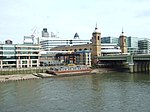St Michael Paternoster Royal
17th-century Church of England church buildingsChristopher Wren church buildings in LondonChurch of England church buildings in the City of LondonChurches bombed by the Luftwaffe in LondonDiocese of London ... and 4 more
English Baroque architectureGrade I listed churches in the City of LondonRebuilt churches in the United KingdomUse British English from November 2014

St Michael Paternoster Royal is a church in the City of London. The original building, which was first recorded in the 13th century, was destroyed in the Great Fire of London in 1666. The church was rebuilt under the aegis of Sir Christopher Wren. However St Michael's was severely damaged during the London Blitz in the Second World War. It was restored between 1966 and 1968. In 1423 Richard "Dick" Whittington, the fabled Lord Mayor of London, was buried within its precincts; although the tomb is now lost.
Excerpt from the Wikipedia article St Michael Paternoster Royal (License: CC BY-SA 3.0, Authors, Images).St Michael Paternoster Royal
College Hill, City of London
Geographical coordinates (GPS) Address External links Nearby Places Show on map
Geographical coordinates (GPS)
| Latitude | Longitude |
|---|---|
| N 51.511172222222 ° | E -0.092155555555556 ° |
Address
St Michael Paternoster Royal
College Hill
EC4R 2RL City of London
England, United Kingdom
Open on Google Maps











